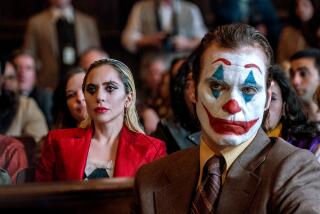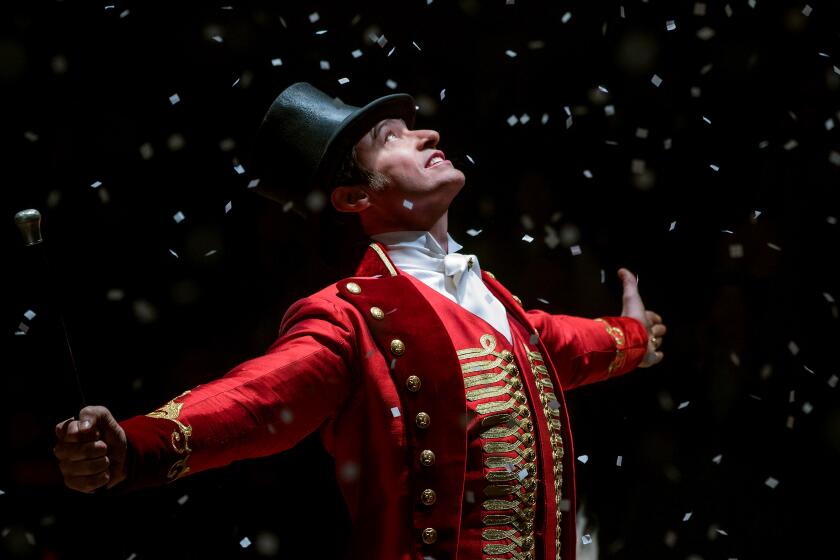The Key to Many Happy Returns
The sequel business was alive and booming this summer.
Most of the season’s sequels (six in all) were successful--five of six are expected to gross $100 million or more--laying the groundwork for yet more installments. In addition, several new films emerged with spinoff potential, including “Shrek,” “Planet of the Apes,” “Lara Croft: Tomb Raider” and “The Fast and the Furious.”
In Hollywood, familiarity breeds content. So it doesn’t take a crystal ball to foresee a return of “The Mummy Returns” and a third “Rush Hour.”
The formula for a hit sequel, according to Fox Filmed Entertainment Chairman Tom Rothman, is simple: It must be “the same, but different--and better than the first.”
In June, Fox released “Dr. Dolittle 2,” starring Eddie Murphy, which actually got off to a slower start at the box office than the original--most sequels open much stronger than the preceding film and fade more quickly. But “Dolittle” managed to sustain audiences of kids and young adults and should end up with almost $110 million, enough to justify a continuation of the dialogue between Murphy and the chatterbox creatures.
“The Mummy Returns” writer-director Stephen Sommers concurs with Rothman that for a sequel to reignite the audience’s interest, it must achieve a balance. It can’t stray too far from the original, nor can it be a line-for-line copy. Before embarking on his second “Mummy,” he says he watched 80 or 90 sequels, “and I learned a lot more from the bad ones, which either were exactly the same as the first or went off in a completely different direction.”
Mary Parent and Scott Stuber, co-presidents of production at Universal, believe that for the success of any sequel it’s crucial to bring back the creative talent that made it work before.
Universal went three for three with sequels this summer--”The Mummy,” “American Pie” and a third installment of “Jurassic Park,” all of which featured actors and other creative elements from the originals.
The decision on whether to proceed with a sequel depends on a studio’s financial strategy, according to Brett Ratner, director of the “Rush Hour” films. But in a business in which production and marketing costs are increasingly prohibitive, having a recognizable title is as close as the major studios come to life insurance.
Sequels are easier to market and, at least for the first weekend, are a proven draw for audiences. So in almost every case the answer to the question “To sequel or not to sequel” a hit film is yes. The exceptions are movies that can’t deliver a sequel--”Titanic,” for example--or the cost of making the film and luring back talent throws the financial structure out of whack.
Although “Rush Hour 2” was almost a foregone conclusion, the pressure of doing the original one better and a budget that was almost triple the size of the first movie (“RH2” cost about $90 million compared with the first film’s budget of $33 million, in part due to superstar remuneration for Chan and Tucker) made the second movie “seem almost like an impossibility,” says Ratner. “It was the hardest thing I’ve ever done because after the first one, little kids were coming up to us and reciting lines [from the original “Rush Hour”]. How do you top that kind of experience?”
As with Sommers on “The Mummy Returns,” the key to making “RH2” work, he says, was building the story around the central relationships established in the first film. In the original “Mummy” there was a budding romance between Brendan Fraser and Rachel Weisz. The sequel finds them married with a son, which changes the dynamic as well as deepening their camaraderie.
In “RH2” Ratner decided on a sort of role reversal for the characters. The core of the film is still the interplay between Chan and Tucker. But this time around, Chan had more comic dialogue and Tucker more action. Ratner also reversed their situations. In the first film it was Chan who was out of his element in the U.S. In the second Tucker finds himself confounded by his experiences in Hong Kong.
Interestingly, both “Mummy Returns” and “RH2” added female action sequences to broaden their demographic appeal.
In the case of “Dr. 2” and “JP3,” the filmmakers knew when to leave well enough alone. Producer John Davis said the mixture of Murphy and the loquacious critters required little more than amplification in the second film.
“We knew that the combination appealed to both adults and children,” says Davis. “We just made it bigger.” Possibilities for a third film depend on Murphy’s desire and availability and coming up with a concept that expands further into the animal kingdom, he says.
After taking the dinosaurs for a visit to San Diego in “The Lost World,” the third “Jurassic” returned to the perilous confines of the island and brought back Sam Neill, who sat out the first sequel, from the original blockbuster. The main addition was new and improved dinosaurs and the scientific theory that the prehistoric monsters possessed uncanny communication skills, say Parent and Stuber.
Before sitting down to write “American Pie 2,” Adam Herz also focused on sequels that worked and worked spectacularly: “Toy Story 2,” “Indiana Jones and the Lost Crusade” (the second sequel), “Terminator 2” and “Superman 2.” He says he did not set out to top the original (which he also wrote), but rather tried to make it more like “the next chapter” in the lives of the four young men in the first movie.
“I was making it for fans of the original,” he says, and the fans wanted to laugh, which meant that some of the dramatic advancements he’d written for the characters wound up being excised in the test screening process.
Balancing the same/different aspects of a sequel isn’t foolproof. Unlike the “Scream” movies, which were the basis for the original comedy spoof “Scary Movie,” the sequel’s cast was mostly different, although the behind-the-camera talent was the same. “It’s easier to develop [a sequel] when characters recur,” says Miramax/Dimension partner Bob Weinstein, who says he’s pleased because “Scary Movie 2” will be profitable.
But expectations were clearly higher for “Scary 2.” The industry rule of thumb for a successful sequel is one that grosses about two-thirds as much as the original. That has been the case with “JP3” and “Dr. 2.”
“Scary 2,” however, will do only half as well as the first film, putting a damper on the franchise’s future.
Conversely, “Mummy Returns” has grossed more than the first film, and it appears that “Rush Hour 2” will do so as well. “American Pie 2” has gotten off to a sensational start and has a shot at outpacing its predecessor or at least coming very close. That leaves the door open and for new installments of all three films.
Studio executives like Rothman, Parent and Stuber contend that fashioning viable stories is the key component to the continuation of a franchise.
“The trick of it is, the deeper into a series you go, the more outstanding pictures have to be,” says Rothman, “in order to overcome the sense of deja vu .”
The overriding component, however, is economic. Franchise films are designed to be golden geese for studios and will continue as long as they make financial sense.
“The art of making a sequel,” says Davis, “is that you either have to make it better than the original, or be certain it opens so big that it doesn’t matter.”
Even then, escalating costs can signal the end of a franchise. The fourth “Lethal Weapon,” which grossed $130 million, cost well over $100 million to make because of heavy profit participation for talent, which made a fifth seem economically unfeasible--not to mention that the key players, Mel Gibson and Danny Glover, are getting a tad long in the tooth for action films. With that in mind, “Mummy,” “Jurassic” and “Dolittle” sequels were not significantly more expensive than their predecessors, allowing each to turn a substantial profit.
“American Pie 2” cost nearly three times as much as the first ($30 million versus $11 million), but it appears to be well on its way to profit since it opened to $45.1 million. Since the “Pie” franchise depends on an ensemble cast and no special effects, costs on future installments need not rise exponentially.
The same applies to “Scary 2,” which will turn a profit, though at a cost of $45 million, nowhere nearly as much as the original, which cost less than $20 million and grossed $150 million. A “Scary 3” would probably have to be made for less money and with an extremely clever concept since it has to overcome the onus of being the follow-up to a movie that was less satisfying.
Even when a sequel is a bigger hit than its predecessor, continuing with the series is not without problems. “RH2,” had such a high price tag, creating a third will require structuring things carefully so that it works financially, according to New Line marketing chiefs Rolf Mittweg and Russell Schwartz. “We have to come up with a unique formula [with talent] more like a partnership, so that there’s a certain [financial] comfort level,” said Schwartz, “and that’s a bit of a trick.”
The Summer Sequels: How Did They Do? “The Mummy Returns”
$201.3 million to date
Why it worked: It got there first and was bigger in scope than the first.
Will it continue? The second out-grossed the original. Need we say more?
“Jurassic Park III”
$163.1 million to date
Why it worked: Back to the island. New dinosaurs.
Will it continue? Likely, but not assured.
“Dr. Dolittle 2”
$109 million to date
Why it worked: Kids and parents loved Eddie Murphy talking to animals.
Will it continue? How about dropping Eddie Murphy into a “Planet of the Apes” sequel?
“Rush Hour 2”
$144 million to date
Why it worked: The chemistry between Tucker and Chan; a more exotic locale and more action.
Will it continue? You can set your watch by it.
“American Pie 2”
$45.1 million opening weekend,
$62.1 million as of Thursday
Why it worked: The same combination of raunchy and sweet.
Will it continue? College graduation, anyone?
“Scary Movie 2”
$70.9 million to date
Why it worked, but not as well: Same shamelessly raunchy humor, but it seemed rushed and underdeveloped.
Will it continue? Unlikely, but never say never.
More to Read
Only good movies
Get the Indie Focus newsletter, Mark Olsen's weekly guide to the world of cinema.
You may occasionally receive promotional content from the Los Angeles Times.










